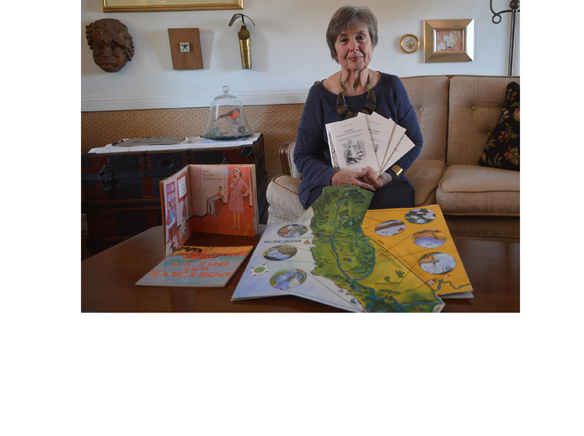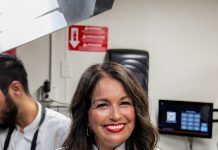Eldonna Lay not only knows the rich history of El Cajon, she lives and breathes it. Along with her many other contributions, her place it in El Cajon’s history is marked in ink.
Eldonna Lay not only knows the rich history of El Cajon, she lives and breathes it. Along with her many other contributions, her place it in El Cajon’s history is marked in ink.
As an author, educator and member of the El Cajon Historical Society, Lay’s commitment to writing goes well beyond childish entertainment. Whether it be a series of children’s books based on historical locals for education, a kleptomaniac kangaroo or the history of El Cajon, she infused her values for writing, teaching and history into works that stand the test of time.
“My philosophy is that everybody needs to bond with a place and I wanted children to have at least one place in their childhood that was secure and provided them a grounding,” she said. “So when they matured here in the schools they were loved, taken care of, and fed, they could align themselves with other children100 years before. I wanted that common thread for children here in El Cajon.”
Lay is speaking of a series of books she prepared and published for the Historical Society, “East County Childhoods” used in the school district for years as part of its curriculum. They follow the history of the Asher-Vacher family, and Lay wanted to write books about El Cajon. She said she was finally “forced” into it by a longtime family friend George Paul. His parents owned the ranch on Fuerte Drive and insisted that he tell his story to Lay. He finally packed his bags and said he was moving in until his story was told.
“At the time, I don’t know if he knew at the time, but he had Alzheimer’s and was desperate to get his story out. So that’s how “Summers at the Paul Ranch” came in,” she said.
Around the curve from that was Eugene de Bac Vacher. His mother was the last white child to be born in Old Town when the city of San Diego was being formed. Her father was the first florist in New Town. New Town founders, Josephus Asher and Alonzo “Father” Horton met on the ship coming down to San Diego. Asher was huge in agriculture so he bought land where Parkway Plaza sits now. His daughter, Josephine Asher (Vacher) was the oldest child out of seven, and her younger brothers Robert Asher turned out to be the Hermit of Palomar. One of her other brothers founded Pacific Beach.
“This is a real high level family,” she said. “Josephine had a son Eugene, and he died just a few years ago. He lived just a few houses down from me so I asked him if we could do stories about his mother. So there are two books about his mother as a school teacher and one book on him. So it’s a series of books centered on the curve on Fuerte Drive. So children here, could have a connection to that property in El Cajon.”
This three set book included “Josephine of San Diego’s Old and New Towns,” “Pioneer Teacher Josie Grows Up,” and the third about her son “The Boy Who Loved Music.” She wrote curriculum and projects for teachers and the series of books were provided to all of the schools and paid for by the Friends of East County Arts. In addition she wrote a book of what it might have been like at Christmas for the Amaziah Lord Knox family. “An 1890 Knox Family Christmas” explains some of the things in the Knox Museum. It is based on true stories, but not dictated so somewhat fictional.
“I interviewed people for it, said Lay, “It’s a far more casual book. I broke all of these books down to what a third grader could read and used vocabulary of other books for children that age.”
Lay thinks these books would do very well in today’s schools with teachers that teach that part of the course.
“With the new curriculum coming in, who knows what place they have, but they are available at the Knox and they are only $3 a piece, so school budgets could have those,” she said. “We have about 100 copies each, but if the demand is there the Historical Society will be sure that they get published.”
As for her long term relationship with the Historical Society, Lay said she was forced into the El Cajon Historical Society by Assistant Superintendent of CVUSD, Rex Dahms.
“After earning a Master’s Degree from SDSU in curriculum and originating a series of videos on carbon dating of findings in a local archaeological dig, I invited some non-member former teachers in originating the Society’s pre-tour book and activities packet for third-grade teachers and students. This was in preparation for student tours of the Knox House Museum,” she said. “It included appropriate background information, maps, and photographs of town founder Amaziah Knox’s first hotel, and later, his family’s home.”
Lay said it gives a peek into what and how settlers brought furnishings to El Cajon when it was just a tiny Southern California frontier village.
“It is important, we members believe, for current residents and their children to witness for themselves the differences between then and now,” she said “I am grateful to have been entrusted for nearly 30 years as the curator heading a committee in appropriately furnishing the Museum’s 1890-1912 interior.”
The Knox museum is open for accompanied free public tours on alternate Saturdays. Private tours for small adult and children’s groups can be scheduled, as well as by serious researchers wanting access to information in its library, publications or in purchasing photographs. Lay said it is intellectually satisfying and interesting to watch residents and tourists to visit any city’s historic buildings.
“We are the only 100-year-old public building among many privately owned houses and stores that remain in our city,” she said. “For newcomers to our area, knowing what came before them is valuable in recognizing and understanding today’s local customs. For children, knowing what kids did in the old days before iPhones helps them feel a part of a community that is financially and culturally reliable, as well as dependably concerned about the health, education and physical welfare of its residents.”
Lay’s writing began when she was a first grade teacher and teaching college. She wrote curriculum for her students and it became a “gifted class,” four years ahead in every area. So much so that San Diego State came out to see what was going on with these remarkable children. She wrote out her curriculum and it was in use for 25 years. Not everything is curriculum with Lay, although she said it must have purpose. Her approach to writing children’s stories was more than the common “Look Dick, Look Jane” books of the times.
“There really has to be a moral to the story so my story would be about it doesn’t pay to lie,” she said. “And that was a story about a kleptomaniac kangaroo (“C.A. Zoo and Kangaroo”). I had complete say with the artist, so this kangaroo would bounce around putting things in its pouch. The kids just loved it.”
In another book she insisted that the parents in the story not portray the art of the perfect nuclear family, with the father wearing a sweater with a hole in it, not a suit. The mother dressed without pearls and the perfect dress and the furniture that portrayed the common family
“I felt it impeditive to do that and it was the first time that books like that had regular people with no class identification tied to them,” she said.
Lay also wrote her first column “Ocean Currents” for Ocean’s Magazine, a new magazine published in America and Europe. Three days after the magazine hit the streets, her column “Sea Squirts” was purchased by Encyclopedia Americana.
“I’ll be honest with you. That is when I really found out that I could do research,” she said. “I didn’t remember what I learned in eight grade so I went out to Scripps and did interviews. My skill is breaking down complicated information into common language. I wanted to entertain as well as inform people. I’m trying to make it readable, interesting and entertaining without talking down to anybody or being lofty.”
Lay is also working with the city of El Cajon in updating her book “The History of El Cajon: Valley of Opportunity,” commissioned by the city for its historic 75th anniversary. Once completed the city will arrange its release to the public. For the past few years Lay devoted most of her time to researching and writing one book. She said, serious writing requires most of an author’s creativity, thought processes and energy.
“So I’ve had to temporarily abandon nearly all of my normal social and community activities and until this past year the historical society,” she said. “So, when this book goes to the printer I will begin apologizing to all of the people I’ve had to ignore.”














